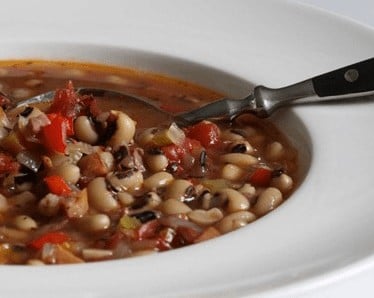Black eyed pea soup
black-eyed pea soup, black eyed bean soup
The black-eyed pea or black-eyed bean is a legume grown around the world for its medium-sized, edible bean. It is a subspecies of the cowpea, an Old World plant domesticated in Africa, and is sometimes simply called a cowpea. The common commercial variety is called the California Blackeye; it is pale-colored with a prominent black spot. The American South has countless varieties, many of them heirloom, that vary in size from the small lady peas to very large ones. The color of the eye may be black, brown, red, pink, or green. All the peas are green when freshly shelled and brown or buff when dried. A popular variation of the black-eyed pea is the purple hull pea or mud-in-your-eye pea; it is usually green with a prominent purple or pink spot. The currently accepted botanical name for the black-eyed pea is Vigna unguiculata subsp. unguiculata, although previously it was classified in the genus Phaseolus. Vigna unguiculata subsp. dekindtiana is the wild relative and Vigna unguiculata subsp. sesquipedalis is the related asparagus bean. Other beans of somewhat similar appearance, such as the frijol ojo de cabra of northern Mexico, are sometimes incorrectly called black-eyed peas, and vice versa. The Black-eyed pea originates from West Africa and has been cultivated in China and India since prehistoric times. It was grown in Virginia since the 17th century by African slaves who were brought to America along with the indigenous plants from their homelands. The crop would also eventually prove popular in Texas. The planting of crops of black-eyed peas was promoted by George Washington Carver because, as a legume, it adds nitrogen to the soil and has high nutritional value. Throughout the South, the black-eyed pea is still a widely used ingredient today in soul food and cuisines of the Southern United States. The black-eye pea is cultivated throughout the world.
Source: Wikipedia
Recipes

Black Eyed Pea Soup - melissassouthernstylekitchen.com





:max_bytes(150000):strip_icc()/InstantPotBlackeyedPeas_0001-66d41dd6e8fa4f2bae284ef6e982ca9c.jpg)







:max_bytes(150000):strip_icc()/Black-eyed-pea-soup-GettyImages-147454928-5aabe396c6733500362d81f5.jpg)
:max_bytes(150000):strip_icc()/4413396-5c24955968b54238ba25de4dc181dfb1.jpg)

:max_bytes(150000):strip_icc()/__opt__aboutcom__coeus__resources__content_migration__serious_eats__seriouseats.com__recipes__images__2014__01__20140109-sausage-kale-and-black-eyed-pea-soup-3-dea3a836aa5c4215bed0817d5e69e1db.jpg)

:max_bytes(150000):strip_icc()/8672702-c37783b4172e4001b7495990a376c5b5.jpg)